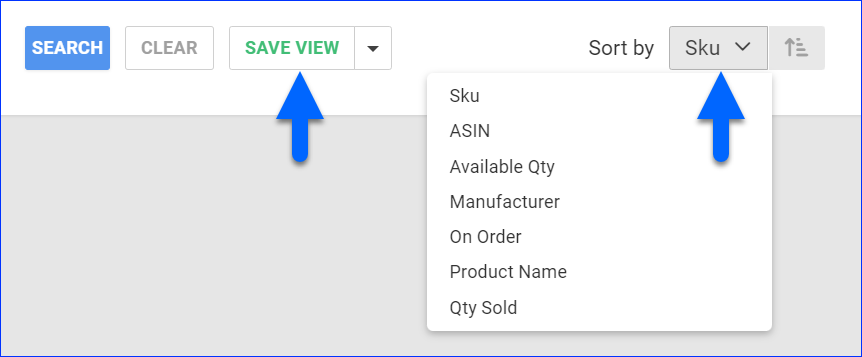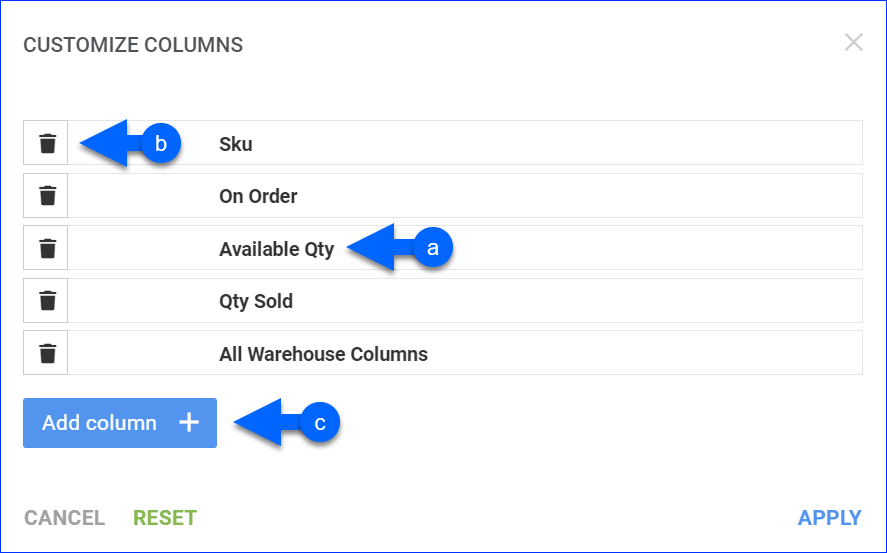Overview
In this article, you will learn about Sellercloud’s Quantity Sold By Warehouse report. This report shows you how many units were shipped from each of your warehouses in a specific date range. It also provides information about the currently available and on-order inventory. You can see the following:
- Product Information: Product Name, SKU, ASIN, and Manufacturer.
- Inventory Information: On Order, Available Quantity, and Quantity Sold.
The inventory information in the report always reflects your current inventory, regardless of the selected date range. - Warehouse Information: Product Quantity Sold Per Warehouse.
You can run this report automatically on a regular basis with Scheduled Tasks.
For more information about Sellercloud’s Financial Reporting Suite, see the Reports FAQ.
Access and Customize the Report
To use the report:
- Navigate to Reports > Sales > Qty Sold By Warehouse.
- Select date filters – Date Range or Date.
- Set up the Default and Custom filters to have the report show precisely what you need.
- Click Search. Each filter you apply gets highlighted in orange, and after you click Search, it turns green. If a filter is gray or not displayed at all, it’s not active.

- To manage the columns in the report, click the three dots icon on the top right and select Customize Columns. You can:
- To sort the data differently, use the Sort by menu.
- To save your filtering and sorting options, click Save view, type a Name, and click Save.

- To export the full report to a spreadsheet, click Actions on the bottom right and select Export to Excel. You can also export to CSV or PDF. Spreadsheet exports always include all columns, even those hidden in the report’s web UI due to the 13-column limit.

Filter Definitions
Default Filters
| Filter | Description |
| Company | Include only orders from one or more Companies. |
| Channel | Include only orders from one or more Channels. |
| Date Range | Select a preset date range from Yesterday to Last Year. |
| Date | Enter the Start and End dates. For a single date, choose the same Start and End date. |
Custom Filters
| Filter | Description |
| Brands | Include only products from one or more Brands. |
| Company Groups | Include only products from one or more Company Groups. |
| Exclude Dropship | Exclude information about Dropship inventory from the report. |
| Manufacturer | Include only products from one or more Manufacturers. |
| Product Group | Include only products from one or more Product Groups. |
| Purchaser | Include only products with a specific user assigned as Purchaser. |
| SKU | Include only one or more SKUs. |
| Use Original Product ID | For Shadow Products, select Yes for the report to show the original shadow SKU the item was sold under. Select No to see only parent SKUs. |
| Vendor | Include only products with their Default Vendor set to any of the selected. For Dropship orders, this will be the vendor from which the products were purchased. |
| Warehouse | Include only orders shipped from one or more Warehouses. |
Report Data
| Column | Field Data | Description |
| SKU | ProductID | Shows the product’s SKU. For Shadow Products, this column depends on the Use Original ProductID Custom Filter. |
| *ASIN | ASIN | Shows the product’s Amazon Standard Identification Number (ASIN). |
| *Product Name | ProductName | Shows the SKU’s product name. |
| *Manufacturer | Manufacturer | Shows the product’s Manufacturer. |
| On Order | OnOrder | Shows the number of units that are currently unreceived on open POs. |
| Available Qty | InventoryAvailableQty | Shows the product’s current number of units available for sale across all warehouses. |
| Qty Sold | Sum of Qty | Shows the total number of product units sold. |
| All Warehouse Columns | Sum of Qty Sold per Ship From Warehouse | Each warehouse column shows the total number of product units shipped from that specific Shipping Warehouse in the selected date range. |
You can add columns listed with an asterisk (*) to the grid by following the instructions outlined in step 5 of the Access and Customize the Report section.
